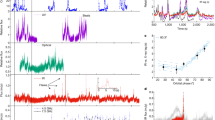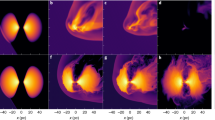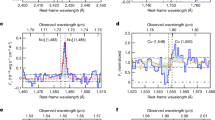Abstract
Most theoretical discussions of active galactic nuclei (including quasars) attribute their energy production either to an accreting black hole or to a precursor stage—for instance a dense star cluster or a supermassive star—whose inevitable end point is a massive black hole1. We explore here the possibility that some active nuclei may contain two massive black holes in orbit about each other. This hypothesis suggests a new interpretation for the observed bending2 and apparent precession3 of radio jets emerging from these objects and may indeed be verified through detection of the direct consequences of orbital motion.
This is a preview of subscription content, access via your institution
Access options
Subscribe to this journal
Receive 51 print issues and online access
$199.00 per year
only $3.90 per issue
Buy this article
- Purchase on Springer Link
- Instant access to full article PDF
Prices may be subject to local taxes which are calculated during checkout
Similar content being viewed by others
References
Begelman, M. C. & Rees, M. J. Mon. Not. R. astr. Soc. 185, 847 (1978).
Readhead, A. C. S., Cohen, M. H., Pearson, T. J. & Wilkinson, P. N. Nature 276, 768 (1978).
Ekers, R. D., Fanti, R., Lari, C. & Parma, P. Nature 276, 588 (1978).
Thorne, K. S. & Braginsky, V. B. Astrophys. J. Lett. 204, 1 (1976).
Blandford, R. D. Sources of Gravitational Radiation (ed. Smarr, L.) (Cambridge University Press, 1979).
Ostriker, J. P. & Tremaine, S. D. Astrophys. J. Lett. 202, 113 (1975).
Ostriker, J. P. & Hausman, M. A. Astrophys. J. Lett. 217, 125 (1977).
White, S. D. M. Mon. Not. R. astr. Soc. 191, 1 (1980).
Tubbs, A. preprint (1980).
Wyndham, J. D. Astrophys. J. 144, 459 (1966).
Heggie, D. C. Mon. Not. R. astr. Soc. 173, 729 (1975).
Frank, J. & Rees, M. J. Mon. Not. R. astr. Soc. 176, 633 (1978).
Lynden-Bell, D. in Relativity Theory and Astrophysics Vol. 2 (ed. Ehlers, J.) 131 (American Mathematical Soc., 1967).
Collins, G. W. Astron. Quart. 1, 39 (1977).
Rees, M. J. Nature 275, 516 (1978).
Martin, P. G. & Rees, M. J. Mon. Not. R. astr. Soc. 189, 19p (1979).
Begelman, M. C. et al. Astrophys. J. 238, 722 (1980).
Cohen, M. H. & Readhead, A. C. S. Astrophys. J. 233, L101 (1979).
Saslaw, W. C., Valtonen, M. J. & Aarseth, S. J. Astrophys. J. 190, 253 (1974).
Young, P. J. et al. Astrophys. J. 221, 721 (1978).
Author information
Authors and Affiliations
Rights and permissions
About this article
Cite this article
Begelman, M., Blandford, R. & Rees, M. Massive black hole binaries in active galactic nuclei. Nature 287, 307–309 (1980). https://doi.org/10.1038/287307a0
Received:
Accepted:
Published:
Issue Date:
DOI: https://doi.org/10.1038/287307a0
This article is cited by
-
Exploring the nature of black hole and gravity with an imminent merging binary of supermassive black holes
Science China Physics, Mechanics & Astronomy (2023)
-
Implications for the supermassive black hole binaries from the NANOGrav 15-year data set
Science China Physics, Mechanics & Astronomy (2023)
-
Lunar Gravitational-Wave Detection
Space Science Reviews (2023)
-
Science with the 2.5-meter Wide Field Survey Telescope (WFST)
Science China Physics, Mechanics & Astronomy (2023)
-
Unveiling the population of dual and lensed active galactic nuclei at sub-arcsec separations
Nature Astronomy (2022)
Comments
By submitting a comment you agree to abide by our Terms and Community Guidelines. If you find something abusive or that does not comply with our terms or guidelines please flag it as inappropriate.



